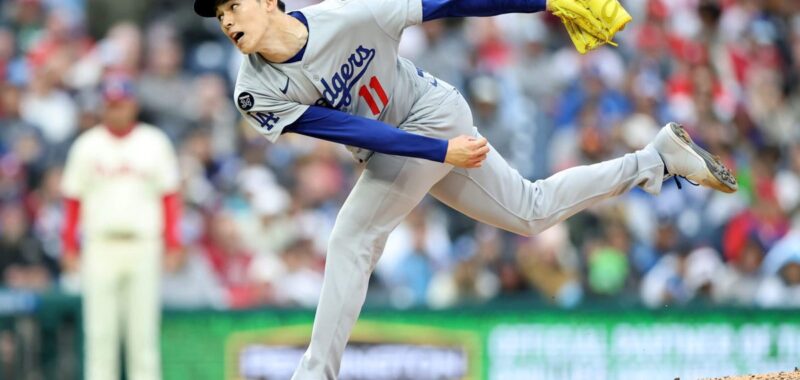PHILADELPHIA — A week ago, Roki Sasaki sought an escape from the bottom. The 23-year-old could not locate his fastball, or locate anything, and departed after just five outs, disappearing down the tunnel toward the clubhouse. His manager summoned him back to watch the aftermath. So Sasaki sat along the railing, with his eyes red, and watched. The footage fueled speculation the young starter had been crying, stirring a round of criticism from former big leaguers, adding fuel to a baseball public already irritated by his choice to sign with the Los Angeles Dodgers. To the Japanese media, Sasaki denied he was crying.
A week later, he found elation. The budding talent had turned in the finest start of his big-league career to date, taming the Philadelphia Phillies in a raucous ballpark. Yet he still stood along the railing, agonizing over the two base runners he’d left for Anthony Banda to handle. As Banda escaped, Sasaki raised his wiry frame atop the rail and roared.
What a difference it was for the Japanese phenom, who got his transition to Major League Baseball back on track in the Dodgers’ 3-1 win.
Dave Roberts could not help but temper expectations for Sasaki in the buildup. Sasaki still represents an unknown, a blindingly talented pitcher who for at least two big-league starts had seemingly no clue where the baseball was going. His first road start did not represent a soft landing. This series, in this ballpark, is a “barometer” for each of these two clubs in the season’s early slate, Roberts said. Introducing a rookie going through Sasaki’s struggles seemed to be adding kerosene to a burning topic.
Instead, Sasaki put something on screen that baseball executives had dreamed was possible for him, allowing one run over four innings and throwing enough competitive strikes to show off the unique arsenal that made him so sought after this winter. It’s what everyone needed.
“He knows that he can do it here,” Roberts said.
The Dodgers have urged Sasaki to be aggressive with his fastball. His devastating splitter would be useless without first establishing everything else in the strike zone.
“It’s everything,” Roberts said. “When you’re facing big-league hitters who are very disciplined, they’re going to be patient. I just think that the approach right now, until otherwise shown, they’re going to try to wait him out and force him to be in the hitting zone. If he’s in the strike zone, then you can kind of flip the script a little bit.”
Be it through trust or the blunt force of miserable results, Sasaki has adapted, and listened. Catcher Austin Barnes was behind the plate for Sasaki’s bullpen session in between starts, where Sasaki tweaked how his lower half functioned in his delivery. Something clicked. Sasaki was able to put things where he wanted to.
“I felt I had something,” Sasaki said through interpreter Will Ireton. “Last time around, I felt like I wanted to throw strikes, but I couldn’t. I really worked on my mechanics since that game and really felt like I was able to do that today.”
The change sparked some confidence. Before the start, Sasaki found Barnes. He nudged his catcher, telling him, “Let’s go,” in English. He relaxed. Strikes followed.
The Phillies, seemingly prepared for such a tone, jumped on two of the first fastballs they could see from Sasaki for singles. One of them would score.
Still, the aggressiveness opened up everything else. He wouldn’t allow another hit until his final batter of the night. The more he used the fastball in the strike zone and got ahead, the more he could use his splitter. “It’s the best pitch I’ve ever seen,” Banda said of it this spring. “One of the best splitters I’ve ever caught,” catcher Will Smith said just a week ago. The pitch tumbles and knuckles and dives and makes those who swing look foolish.
The Phillies swung at 10 of them and missed five times. All four of Sasaki’s strikeouts came on the pitch.
“It’s a crazy pitch,” said Barnes, who was behind the plate again Saturday.
“The splitter from the side looked like he was throwing (Tyler) Glasnow’s curveball,” Max Muncy said. “That’s the kind of movement from the side that it has. I know it’s not the same, but the bottom’s falling out of it.”
Sasaki pitched into the fifth inning for the first time in his brief career, issuing a walk and single to lead off the frame before Roberts came and summoned him. The right-hander had to watch as Banda attempted to hold a one-run lead. The Dodgers benefitted from a goof: When Bryson Stott broke for second base on a full-count offering, he misjudged the contact he saw looking back at home plate. Kyle Schwarber’s liner went directly to Teoscar Hernández in right field. Hernández’s ensuing throw beat Stott back to first base to end the inning before J.T. Realmuto could score from third base.
“A huge play,” Roberts said. It was as close as the Phillies would come to scoring again the rest of the night.
Sasaki could smile. So could the Dodgers.
“I did go through the week feeling a little anxious,” Sasaki said. “I was searching for something that I could feel confident about.”
Clearly, he’s found something. Pushing that through to the next outing, and then the next, is a tantalizing thought.
“Everything is under a microscope right now, because of all the hype,” said Kiké Hernández, who slugged the go-ahead two-run homer. “But if it was any other random name who struggled through their first two starts, nobody would be making a big deal out of it. So I think the kid’s going to be more than all right, and he showed that today. There’s no need to panic over one or two bad outings.”
(Photo: Emilee Chinn / Getty Images)

